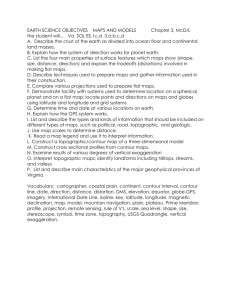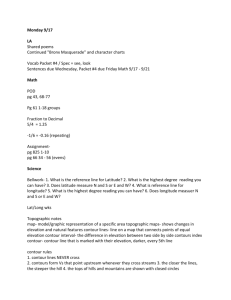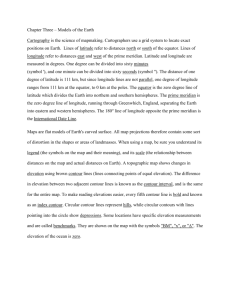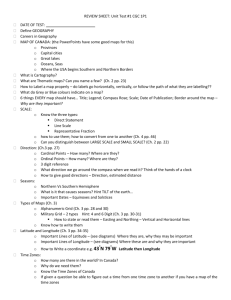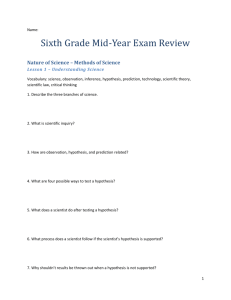Study Guide
advertisement
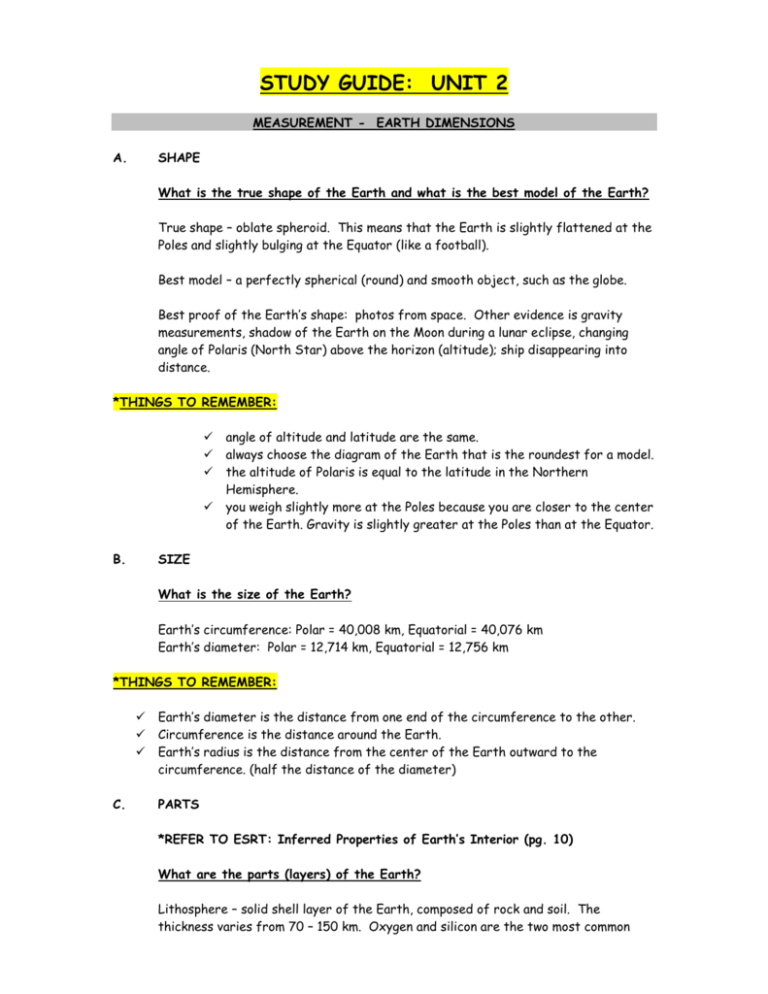
STUDY GUIDE: UNIT 2 MEASUREMENT - EARTH DIMENSIONS A. SHAPE What is the true shape of the Earth and what is the best model of the Earth? True shape – oblate spheroid. This means that the Earth is slightly flattened at the Poles and slightly bulging at the Equator (like a football). Best model – a perfectly spherical (round) and smooth object, such as the globe. Best proof of the Earth’s shape: photos from space. Other evidence is gravity measurements, shadow of the Earth on the Moon during a lunar eclipse, changing angle of Polaris (North Star) above the horizon (altitude); ship disappearing into distance. *THINGS TO REMEMBER: B. angle of altitude and latitude are the same. always choose the diagram of the Earth that is the roundest for a model. the altitude of Polaris is equal to the latitude in the Northern Hemisphere. you weigh slightly more at the Poles because you are closer to the center of the Earth. Gravity is slightly greater at the Poles than at the Equator. SIZE What is the size of the Earth? Earth’s circumference: Polar = 40,008 km, Equatorial = 40,076 km Earth’s diameter: Polar = 12,714 km, Equatorial = 12,756 km *THINGS TO REMEMBER: C. Earth’s diameter is the distance from one end of the circumference to the other. Circumference is the distance around the Earth. Earth’s radius is the distance from the center of the Earth outward to the circumference. (half the distance of the diameter) PARTS *REFER TO ESRT: Inferred Properties of Earth’s Interior (pg. 10) What are the parts (layers) of the Earth? Lithosphere – solid shell layer of the Earth, composed of rock and soil. The thickness varies from 70 – 150 km. Oxygen and silicon are the two most common elements. Below the lithosphere, the Earth is divided into 4 subsurface layers from the Earth’s center: inner core, outer core, mantle, and crust. Hyrdosphere – the layer directly above the lithosphere, consisting of all the water (oceans, lakes, rivers, groundwater) of the Earth. Average depth of the oceans is 34 km and cover about 70% of the surface. Atmosphere – the gaseous layer surrounding the Earth (78% nitrogen, 21% oxygen, 1% argon, CO2, water vapor). The atmosphere is composed of the troposphere (where all weather occurs), stratophere, mesophere, and thermosphere. *THINGS TO REMEMBER: D. Lithosphere is the most dense (Earth thicker); atmosphere is the least dense (air thinner). Density, pressure, temperature, and depth increase the closer you are to the Earth’s center. MAPS How do we measure the Earth using latitude and longitude? Latitude and longitude are imaginary parallel lines that we use for orientation and location on maps. Longitude runs from North to South, and Latitude runs from East to West. Latitude – the main reference line on the Earth is the Equator, 0 o. Latitude is measured North or South of the Equator between 0o and 90o. Longitude – the main reference line on the Earth is the Prime Meridian, 0 o. This line runs from the North Pole through Greenwich, England to the South Pole. Longitude is measured East or West of the Prime Meridian between 0o and 180o. Topographic maps or contour maps show the shape of the Earth. Isolines (contour lines) connect points of equal elevations on maps. Each contour line is separated by an equal change in elevation called the contour interval. Change in elevation can be determined by using the formula for gradient (slope). Refer to the ESRT formula. Gradient = change in field value Distance TOPOGRAPHIC MAPPING – ELEVATION ISOLINES *THINGS TO REMEMBER: Rules to follow when using topographic maps Contour lines never cross. When a contour line crosses a river (stream) the contour line forms a “V”. The “V” always points upstream. This tells you the direction the river is flowing. Water flows toward the lowest elevation (indicated by a decrease in contour values). The slope (gradient) is steepest when the contour lines are close together and gradual (flat) when they are far apart. Contour lines form loops or are lines that go the edge of the map. The higher elevations on a map are found when the contour lines make smaller closed loops. A depression on a contour map is shown by contour lines with small “hachures” pointing toward the lowest depression. A profile is a vertical cross section (side view) of the land surface between two points on a topographic map representing the shape of the land. (line up with piece of paper, mark, and draw)

